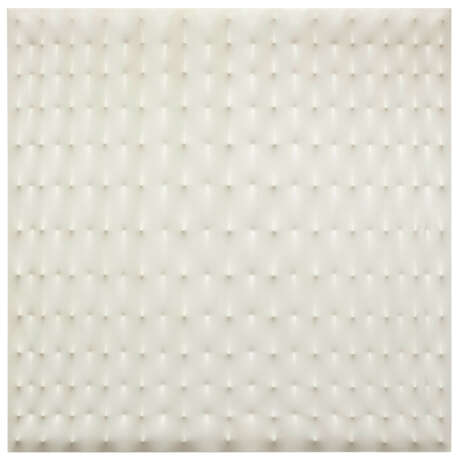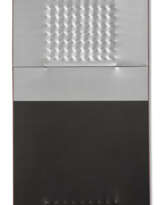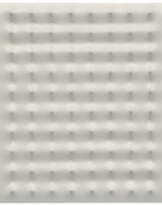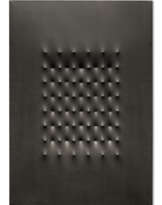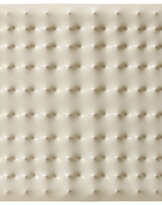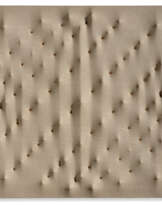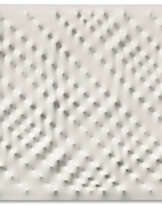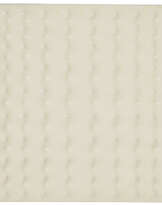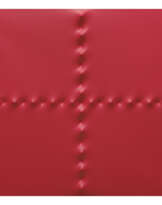ID 832039
Los 31 | Enrico Castellani (1930-2017)
Schätzwert
€ 450 000 – 650 000
Superficie bianca
signé, inscrit et daté 'Enrico Castellani - ''Superficie bianca'' - 1968 -' (au dos)
acrylique sur toile façonnée
120 x 120 cm.
Exécuté en 1968
signed, inscribed and dated 'Enrico Castellani - ''Superficie bianca'' - 1968 -' (on the reverse)
acrylic on shaped canvas
47 1/4 x 47 1/4 in.
Executed in 1968
Provenance
Collection Felice Valadè, Milan.
Collection particulière, Italie.
Vente, Sotheby's, Milan, 27 mai 2014, lot 7.
Acquis lors de cette vente par le propriétaire actuel.
Special notice
Artist's Resale Right ("droit de Suite").
If the Artist's Resale Right Regulations 2006 apply to this lot, the buyer also agrees to pay us an amount equal to the resale royalty provided for in those Regulations, and we undertake to the buyer to pay such amount to the artist's collection agent.
ƒ: In addition to the regular Buyer’s premium, a commission of 5.5%
inclusive of VAT of the hammer price will be charged to the buyer.
It will be refunded to the Buyer upon proof of export of the lot
outside the European Union within the legal time limit.
(Please refer to section VAT refunds)
This item will be transferred to an offsite warehouse after the sale. Please refer to department for information about storage charges and collection
details.
Post lot text
« Une surface blanche vide est la chose la plus abstraite que l'on puisse imaginer ». - Enrico Castellani-
Exécutée en 1968, aux grandes heures de l'avant-garde italienne d'après-guerre, cette œuvre d'un grand lyrisme est un pur exemple des Superfci qui ont profondément marqué et sculpté la carrière d'Enrico Castellani. Ici, la surface blanche immaculée est parcourue d'ombres et de lumière qui ondulent et dansent au rythme d'un labyrinthe de pics et de creux. Obtenues en étirant des toiles sur des lits de clous, les Superfci de Castellani comptent parmi les propositions artistiques les plus radicales et pénétrantes de leur temps, au même titre que les Tagli de Lucio Fontana ou les Achromes de Piero Manzoni. Résonnant avec le propos du mouvement ZERO en Allemagne et l'esthétique bourgeonnante du minimalisme aux États-Unis, cette série d'œuvres-manifestes cherche à réduire l'art à l'essentiel, en faisant de la toile un relief dépouillé, une entité totalement autonome. Avec son quadrillage impeccable qui dégage une élégance presque sculpturale, la présente œuvre, que Castellani élabore l'année où il expose à documenta IV à Cassel, témoigne d'un jeune artiste au sommet de sa carrière.
« Un rideau monochrome est tombé sur le dernier acte de la peinture ». - Enrico Castellani-
Formé en architecture à l'École de La Cambre de Bruxelles, Castellani est diplômé depuis trois ans lorsque ses premières Superfci voient le jour en 1959. Cette année-là, dans l'effervescence des milieux artistiques milanais, il co-fonde avec Manzoni Azimuth, une revue d'avant-garde complétée par une galerie du même nom qui vont contribuer à ériger Milan parmi les centres névralgiques de l'art contemporain. D'abord créées à partir de noisettes avant d'être jalonnées de clous, les Superfci illustrent pleinement sa volonté d'affranchir l'art de toute notion de narration et de rhétorique : pour Castellani, la toile ne doit plus être une fenêtre ouverte sur le monde, mais un territoire de pure expérimentation, libéré, autosuffsant. À l'heure où il réalise la présente œuvre, l'Italien occupe déjà une place importante sur la scène internationale: il a pris part à la Biennalede Venise à deux reprises et participé à des expositions fondatrices pour sa génération, dont Nul au Stedelijk Museum d'Amsterdam (1962) et The Responsive Eye au Museum of Modern Art de New York (1965). Si Castellani a mené par ailleurs des recherches avec la couleur et les matériaux les plus divers, les monochromes blancs comme celui-cidemeurent sans doute l'expression la plus parfaite de sa vision artistique, dans la mesure où ils constituent – à ses yeux - «la chose la plus abstraite que l'on puisse imaginer» (E. Castellani, cité dans Enrico Castellani, cat. exp., Fondazione Prada, Milan, 2001, p. 17).
"A white empty surface is the most abstract thing one can possibly imagine." - Enrico Castellani-
Executed in 1968, during the heyday of the Italian post-war avant-garde, the present work is a pure and lyrical example of Enrico Castellani’s career-defining Superfici. Light and shadow undulate across its pristine white surface, dancing rhythmically through its maze of peaks and troughs. Created by stretching canvas over a bed of nails, Castellani’s Superfici stood among the most radical and profound artistic statements of their time, taking their place alongside Lucio Fontana’s Tagli and Piero Manzoni’s Achromes. Resonating with the aims of the ZERO group in Germany, as well as the emerging aesthetics of Minimalism in America, they sought to strip art down to its most elemental components, transforming the canvas into an autonomous, self-defining entity. Created the same year that Castellani featured at Documenta IV in Kassel, the present work attests to an artist at the height of his early career, its immaculate linear grid exuding a near-sculptural elegance.
"A monochrome curtain has been lowered on the last act of painting." - Enrico Castellani-
Castellani began his Superfici in 1959, three years after graduating with a degree in architecture from the École de La Cambre in Brussels. The same year, amid the thriving artistic milieu of post-war Milan, he and Manzoni co-founded the seminal journal Azimuth and the accompanying Galleria Azimut, establishing the city as an important new centre for contemporary art. Originally created using hazelnuts before transitioning to nails, the Superfici embodied his desire to free art from all previous rhetoric and narrative: the canvas was no longer a window onto the world, but rather a liberated zone of creativity in its own right. By the time of the present work, Castellani had taken his place on the global stage, having exhibited twice at the Venice Biennale and featured in epoch-defining shows including Nul at the Stedelijk Museum, Amsterdam (1962) and The Responsive Eye at the Museum of Modern Art (1965). While he would experiment with a range of colours and materials, white works such as the present stand among the purest expression of his artistic goals, representing—for him—‘most abstract thing one can possible imagine’ (E. Castellani, quoted in Enrico Castellani, exh. cat. Fondazione Prada, Milan 2001, p. 17).
| Künstler: | Enrico Castellani (1930 - 2017) |
|---|---|
| Kunst Stil: | Nachkriegskunst |
| Herkunftsort: | Italien, Europa |
| Kategorie des Auktionshauses: | Gemälde |
| Künstler: | Enrico Castellani (1930 - 2017) |
|---|---|
| Kunst Stil: | Nachkriegskunst |
| Herkunftsort: | Italien, Europa |
| Kategorie des Auktionshauses: | Gemälde |
| Adresse der Versteigerung |
CHRISTIE'S 8 King Street, St. James's SW1Y 6QT London Vereinigtes Königreich | |
|---|---|---|
| Vorschau |
| |
| Telefon | +44 (0)20 7839 9060 | |
| Aufgeld | see on Website | |
| Nutzungsbedingungen | Nutzungsbedingungen |
